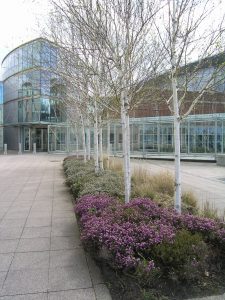
A recent work visit has taken me to Scotland, where twice a year I visit the National Air Traffic Control Centre at Prestwick to see how the landscape management at one of the longest running projects in the terra firma portfolio is progressing nearly 13 years after completion. http://www.terrafirmaconsultancy.com/portfolio/nats-air-traffic-control/
Once a year I visit my older sister in Dundee on the back of this visit, which is always a long awaited and much enjoyed long weekend.
The journey from NATS starts with a train ride across Scotland from Prestwick Town to Glasgow (£8-50 single on Scot Rail) past numerous international standard golf courses: first is Prestwick, famous as the originator of the Open Championship in 1860, the oldest of golf’s four major competitions. The course remained in the Open’s rotation until 1925, when crowd control disrupted play, affecting the outcome, with shots deflecting off spectators! The Open was never held again at Prestwick. Shortly after I pass Royal Troon where recently members voted overwhelmingly to admit women into the club as members, thus avoiding controversy that would have overshadowed the 2016 Open, and potentially to being removed from the Open rota in the future.
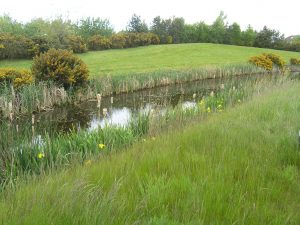
As a seaside course, Troon has numerous tricky holes, long and short, all with plenty of gorse, a plant that has established itself very well at NATS with little assistance, but takes a courageous hand to prune. We cut the gorse back on a sectional yearly rotation after flowering; front face one year, back the next, with top as necessary, always after flowering. It also grows alongside the burn that has to be cleared yearly to avoid backing up and flooding the upstream golf course (luckily not one of the aforementioned ones!) so we keep it clipped as a hedge and are in the process of cutting ‘slots’ to allow access to the burn for machinery.
The train trundles on and I pass places that I’ve heard of but never been to (like the BBC vidiprinter from my childhood): Kilwinning, Glengarnock, Paisley (no sign of Linda still)… I arrive in Glasgow and yet again am surprised by its city centre grid layout. Apparently, Glasgow occasionally doubles for New York and other American cities in films, especially period dramas, as the architecture and layout is in some ways more similar to East Coast American cities than it is most other British cities. I weave my way, left then right, across town from Glasgow Central to Glasgow Queen Street. Next train leg is to Dundee (or Monifieth if I’m lucky and get a stopping train; £23.30 Scotrail). I pass one of my favourite sights just after Dundee; in November the decommissioned oil rigs moored on the north side of the River Tay are lit up and look like part of the City Council’s Christmas decorations.
This year I persuaded my sister to take me on a sight-seeing tour of Dundee’s built environment highlights. Dundee University has a thriving architecture course (https://www.dundee.ac.uk/architecture-urban-planning/) and two particular architectural highlights which I love.
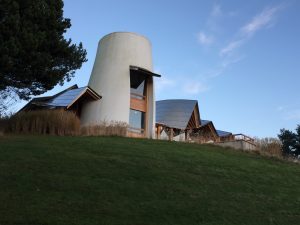
The first is a Maggie’s Centre; designed by architect Frank Gehry, and built in 2003 in the grounds of Ninewells Hospital to the west of Dundee, this was the first new-build Centre. https://www.maggiescentres.org/ The white, cottage-like building with a wavy silver roof is modelled on a traditional Scottish “butt n’ ben” dwelling, which is according to Wikipedia ‘an architectural style for a simple building, usually applied to a residence. The term has been used by archaeologists to describe a basic design of “outer room” conjoined with “inner room” as a residential building plan; the outer room, used as an antechamber or kitchen, is the butt, while the inner room is the ben.’ Now you know. The building has a fascinating shape and sits to the top of a bank above the road, hovering over the road and accentuating the vertical elements.
A sort climb to the top of the surrounding earthworks reveals the ‘garden’, which contains a labyrinth design based on one at Chartres Cathedral, designed by Arabella Lennox-Boyd. Also in the grounds of the Centre is a sculpture by acclaimed artist Anthony Gormley, entitled Another Time X; this is a human-esque statue positioned to look out across the River Tay from the top of the labyrinth banking.
Maggie’s Centres are always a joy to behold. We at terra firma we lucky enough to work on the Swansea Maggie’s Centre designed by the late Japanese architect Kisho Kurokawa and built in 2011; we were involved in detailing the concept landscape design by Kim Wilkie. http://www.terrafirmaconsultancy.com/portfolio/maggies-cancer-care-centre-swansea/
The other highlight is the V&A Dundee, a stunning piece of architecture designed by architects Kengo Kuma & Associates, also Japanese opening this year. https://www.vandadundee.org/ . It sits on the edge of the River Tay next to the RRS Discovery, the first vessel to be constructed specifically for scientific research and Scott’s first Antarctic ship. They ‘sail’ alongside each other with a huge reflective pool between the two. Built through the partnership of Dundee City Council (my sister, as Principal Accountant at Dundee CC, has the thankless task of looking after the VAT), University of Dundee, Abertay University, Scottish Enterprise and the V&A. The building was inspired by the east coast of Scotland and from my walk at Lunan Bay that weekend it is easy to draw parallel with the local cliff formations and the architectural form.
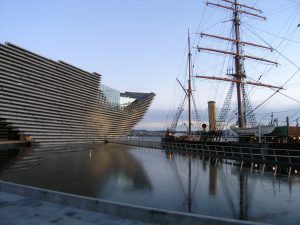
V&A Dundee is also at the heart of a £1 billion waterfront transformation and 30-year project that is hoped to propel a city that has struggled with deprivation towards an improved future. The Dundee Waterfront regeneration was been ranked as the 3rd most active regeneration project in the UK, behind only the Olympic and Wembley Park developments (according to Planning Magazine, 2013) but the city suffered a bad turn on the day I arrived. Dundee was bidding to be European Capital of Culture 2023. Council leader John Alexander said the bid – which included 110 cultural projects across the city – aimed to celebrate what makes the city “truly European”.
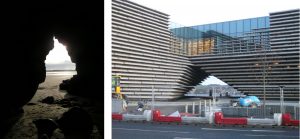
Sadly with Brexit looming, Dundee along with the other 4 UK competitors, Nottingham, Leeds, Milton Keynes, and a joint proposal from Belfast, Londonderry and Strabane, the European Commission announced that the UK selection process should be immediately ‘discontinued’. http://www.bbc.co.uk/news/uk-scotland-tayside-central-42095477 This is hugely disappointing for all involved and a blow to the massive remain majority in Scotland. Here’s to hoping Dundee’s shining transformation is not dulled.
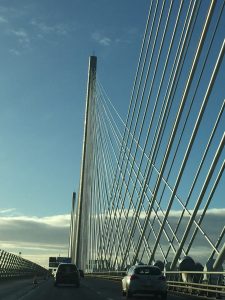
After a weekend much enjoyed, my final highlight was travelling across the ‘Queensferry Crossing’: the third Forth Bridge https://www.theforthbridges.org/queensferry-crossing/ …
What a stunning piece of engineering. I haven’t craned my neck that much since crossing the Millau viaduct.
Dundee’s Cllr. Alexander is quoted as saying “We want a young Lithuanian to point to us [Dundee] on a map and say ‘that’s where my friend lives”.
Despite the disappointment, there is still opportunity for this – least of all with terra firma LT our Lithuanian sister company www.terrafirmaLT.com . They have plenty of young staff and lots of connections… there’s bound to be someone in Dundee… I will ask.